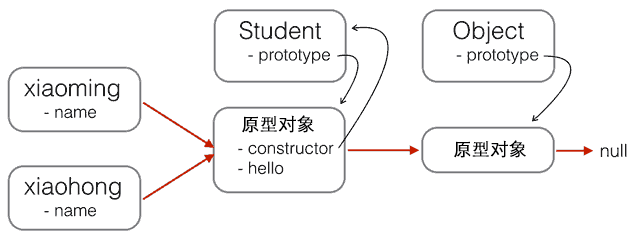04面向对象编程-02-原型继承 和 ES6的class继承
1、原型继承
在上一篇中,我们提到,JS中原型继承的本质,实际上就是 “将构造函数的原型对象,指向由另一个构造函数创建的实例”。
function Student(props) {
this.name = props.name || 'Unnamed';
}
Student.prototype.hello = function () {
alert('Hello, ' + this.name + '!');
}function Student(props) {
this.name = props.name || 'Unnamed';
}
Student.prototype.hello = function () {
alert('Hello, ' + this.name + '!');
}

function PrimaryStudent(props) {
// 调用Student构造函数,绑定this变量
Student.call(this, props);
this.grade = props.grade || 1;
}function PrimaryStudent(props) {
// 调用Student构造函数,绑定this变量
Student.call(this, props);
this.grade = props.grade || 1;
}
new PrimaryStudent() ----> PrimaryStudent.prototype ----> Object.prototype ----> nullnew PrimaryStudent() ----> PrimaryStudent.prototype ----> Object.prototype ----> null
new PrimaryStudent() ----> PrimaryStudent.prototype ----> Student.prototype ----> Object.prototype ----> nullnew PrimaryStudent() ----> PrimaryStudent.prototype ----> Student.prototype ----> Object.prototype ----> null
new PrimaryStudent() ----> Student.prototype ----> Object.prototype ----> nullnew PrimaryStudent() ----> Student.prototype ----> Object.prototype ----> null
var bridge = {}; //创建一个没有内容的对象
bridge.__proto__ = Student.prototype; //让这个对象的原型对象是Student.prototype
bridge.constructor = PrimaryStudent; //让这个对象的构造函数为PrimaryStudent
PrimaryStudent.prototype = bridge; //让PrimaryStudent的原型对象指向bridge
这样一来,原型链就变成了:
new PrimaryStudent() ----> PrimaryStudent.prototype(bridge) ----> Student.prototype ----> Object.prototype ----> null
按照我们比喻的说法,就是:
- 让Student有个儿子bridge(bridge.__proto__ = Student.prototype;)
- 然后这个娃和PrimaryStudent结婚了(bridge.constructor = PrimaryStudent; PrimaryStudent.prototype = bridge;)
- 那么自然PrimaryStudent的子女(通过PrimaryStudent创建的对象),既会老爹bridge的技能,也会爷爷Student的技能”
//验证一下
bridge.do = function(){alert("hahaha")};
var xiaoming = new PrimaryStudent({name:'xiaoming', grade:2});
xiaoming.do(); // 弹框alert("hahaha");
//验证原型
xiaoming.__proto__ === PrimaryStudent.prototype; //true
xiaoming.__proto__.__proto__ === Student.prototype; //true
//验证继承关系
xiaoming instanceof PrimaryStudent; //true
xiaoming instanceof Student; //truevar bridge = {}; //创建一个没有内容的对象
bridge.__proto__ = Student.prototype; //让这个对象的原型对象是Student.prototype
bridge.constructor = PrimaryStudent; //让这个对象的构造函数为PrimaryStudent
PrimaryStudent.prototype = bridge; //让PrimaryStudent的原型对象指向bridge
这样一来,原型链就变成了:
new PrimaryStudent() ----> PrimaryStudent.prototype(bridge) ----> Student.prototype ----> Object.prototype ----> null
按照我们比喻的说法,就是:
- 让Student有个儿子bridge(bridge.__proto__ = Student.prototype;)
- 然后这个娃和PrimaryStudent结婚了(bridge.constructor = PrimaryStudent; PrimaryStudent.prototype = bridge;)
- 那么自然PrimaryStudent的子女(通过PrimaryStudent创建的对象),既会老爹bridge的技能,也会爷爷Student的技能”
//验证一下
bridge.do = function(){alert("hahaha")};
var xiaoming = new PrimaryStudent({name:'xiaoming', grade:2});
xiaoming.do(); // 弹框alert("hahaha");
//验证原型
xiaoming.__proto__ === PrimaryStudent.prototype; //true
xiaoming.__proto__.__proto__ === Student.prototype; //true
//验证继承关系
xiaoming instanceof PrimaryStudent; //true
xiaoming instanceof Student; //true
// PrimaryStudent构造函数:
function PrimaryStudent(props) {
Student.call(this, props);
this.grade = props.grade || 1;
}
// 空函数F,用于后面起桥接作用
function F() {
}
// 把F的原型指向Student.prototype,这样通过F创建的对象,其__proto__属性就是Student.prototype
F.prototype = Student.prototype;
// 把PrimaryStudent的原型指向一个新的F对象,F对象的原型正好指向Student.prototype
PrimaryStudent.prototype = new F();
// 把PrimaryStudent原型的构造函数修复为PrimaryStudent
PrimaryStudent.prototype.constructor = PrimaryStudent;
// 继续在PrimaryStudent原型(就是new F()对象)上定义方法
PrimaryStudent.prototype.getGrade = function () {
return this.grade;
};
// 创建xiaoming
var xiaoming = new PrimaryStudent({
name: '小明',
grade: 2
});
xiaoming.name; // '小明'
xiaoming.grade; // 2
// 验证原型
xiaoming.__proto__ === PrimaryStudent.prototype; // true
xiaoming.__proto__.__proto__ === Student.prototype; // true
// 验证继承关系
xiaoming instanceof PrimaryStudent; // true
xiaoming instanceof Student; // true// PrimaryStudent构造函数:
function PrimaryStudent(props) {
Student.call(this, props);
this.grade = props.grade || 1;
}
// 空函数F,用于后面起桥接作用
function F() {
}
// 把F的原型指向Student.prototype,这样通过F创建的对象,其__proto__属性就是Student.prototype
F.prototype = Student.prototype;
// 把PrimaryStudent的原型指向一个新的F对象,F对象的原型正好指向Student.prototype
PrimaryStudent.prototype = new F();
// 把PrimaryStudent原型的构造函数修复为PrimaryStudent
PrimaryStudent.prototype.constructor = PrimaryStudent;
// 继续在PrimaryStudent原型(就是new F()对象)上定义方法
PrimaryStudent.prototype.getGrade = function () {
return this.grade;
};
// 创建xiaoming
var xiaoming = new PrimaryStudent({
name: '小明',
grade: 2
});
xiaoming.name; // '小明'
xiaoming.grade; // 2
// 验证原型
xiaoming.__proto__ === PrimaryStudent.prototype; // true
xiaoming.__proto__.__proto__ === Student.prototype; // true
// 验证继承关系
xiaoming instanceof PrimaryStudent; // true
xiaoming instanceof Student; // true

function inherits(Child, Parent) {
var F = function () {};
F.prototype = Parent.prototype;
Child.prototype = new F();
Child.prototype.constructor = Child;
}function inherits(Child, Parent) {
var F = function () {};
F.prototype = Parent.prototype;
Child.prototype = new F();
Child.prototype.constructor = Child;
}
function Student(props) {
this.name = props.name || 'Unnamed';
}
Student.prototype.hello = function () {
alert('Hello, ' + this.name + '!');
}
function PrimaryStudent(props) {
Student.call(this, props);
this.grade = props.grade || 1;
}
// 实现原型继承链:
inherits(PrimaryStudent, Student);
// 绑定其他方法到PrimaryStudent原型:
PrimaryStudent.prototype.getGrade = function () {
return this.grade;
};function Student(props) {
this.name = props.name || 'Unnamed';
}
Student.prototype.hello = function () {
alert('Hello, ' + this.name + '!');
}
function PrimaryStudent(props) {
Student.call(this, props);
this.grade = props.grade || 1;
}
// 实现原型继承链:
inherits(PrimaryStudent, Student);
// 绑定其他方法到PrimaryStudent原型:
PrimaryStudent.prototype.getGrade = function () {
return this.grade;
};
- 定义新的构造函数,并在内部用call()调用希望“继承”的构造函数,并绑定this
- 借助中间函数F实现原型链继承,最好通过封装的inherits函数完成
- 继续在新的构造函数的原型上定义新方法
2、class继承(ES6)
class Student {
// 定义构造函数
constructor(name) {
this.name = name;
}
//定义在原型上的函数,没有function关键字,相当于 Student.prototype.hello = function(){...}
hello() {
alert('Hello, ' + this.name + '!');
}
}class Student {
// 定义构造函数
constructor(name) {
this.name = name;
}
//定义在原型上的函数,没有function关键字,相当于 Student.prototype.hello = function(){...}
hello() {
alert('Hello, ' + this.name + '!');
}
}
var xiaoming = new Student('小明');
xiaoming.hello();var xiaoming = new Student('小明');
xiaoming.hello();
class PrimaryStudent extends Student {
constructor(name, grade) {
super(name); // 记得用super调用父类的构造方法!
this.grade = grade;
}
myGrade() {
alert('I am at grade ' + this.grade);
}
}class PrimaryStudent extends Student {
constructor(name, grade) {
super(name); // 记得用super调用父类的构造方法!
this.grade = grade;
}
myGrade() {
alert('I am at grade ' + this.grade);
}
}
04面向对象编程-02-原型继承 和 ES6的class继承的更多相关文章
- 04面向对象编程-01-创建对象 和 原型理解(prototype、__proto__)
1.JS中对象的"不同":原型概念 从Java中我们可以很好地去理解 "类" 和 "实例" 两个概念,可是在JavaScript中,这个概念 ...
- Javascript面向对象编程(三):非构造函数的继承(对象的深拷贝与浅拷贝)
Javascript面向对象编程(三):非构造函数的继承 作者: 阮一峰 日期: 2010年5月24日 这个系列的第一部分介绍了"封装",第二部分介绍了使用构造函数实现&quo ...
- 使用类进行面向对象编程 Class 实例化 和 ES5实例化 对比,继承
ES5 写法 function Book(title, pages, isbn) { this.title = title; this.pages = pages; this.isbn = isbn; ...
- es5继承和es6类和继承
es6新增关键字class,代表类,其实相当于代替了es5的构造函数 通过构造函数可以创建一个对象实例,那么通过class也可以创建一个对象实列 /* es5 创建一个person 构造函数 */ f ...
- python04 面向对象编程02
为啥要用类而不用函数呢 记住两个原则: 减少重复代码 代码会经常变更 2 会对变量或字符串的合法性检测(在实例初始化的时候能够统一初始化各个实例的变量,换做函数来说,要弄出同样的变量那么在初始化 ...
- Javascript面向对象编程(三):非构造函数的继承 by 阮一峰
今天是最后一个部分,介绍不使用构造函数实现"继承". 一.什么是"非构造函数"的继承? 比如,现在有一个对象,叫做"中国人". var Ch ...
- (转)Javascript面向对象编程(三):非构造函数的继承(作者:阮一峰)
不使用构造函数实现"继承". 一.什么是"非构造函数"的继承? 比如,现在有一个对象,叫做"中国人". var Chinese = { na ...
- Javascript面向对象编程(三):非构造函数的继承
转载自:http://www.ruanyifeng.com/blog/2010/05/object-oriented_javascript_inheritance_continued.html 一.什 ...
- JS面向对象编程(三):非构造函数的继承
一.什么是"非构造函数"的继承? 现在有一个对象,叫"中国人". var Chinese = { ...
随机推荐
- 调用Class.forName()要抛出异常
今天学JDBC时,用到下面的程序: package bo; import java.sql.Connection; import java.util.ArrayList; import java.ut ...
- Eclipse 安装插件(aptana、svn 、git、Java EE、JSHint)
转发9 1.安装 aptana 插件: * 依次点击:Help -> Install New Software... -> Add * 输入:http://download.aptan ...
- 【Ubuntu 16】深入Ubuntu文件系统
Ubuntu文件系统的设计目的就是把文件有序地组织在一起,提供一个从逻辑上组织文件的文件系统.除了文件的组织外,文件安全也是文件系统的设计要点,所以文件的访问权限是文件系统不可缺少的组成部分 Ubun ...
- 【Oracle】表空间管理
--表空间管理为主.附带 权限管理.数据字典 /* 表空间是逻辑结构,数据文件是物理结构 一个表空间对应多个段segment 段可以对应多个数据文件.跨磁盘 一个段对应多个盘区 extent 一个盘区 ...
- Java自定义注解及使用
本文通过一个简单的例子展示注解的工作原理. 1.声明注解类型 @Target(value = ElementType.METHOD) //声明该注解的运行目标: 方法 @Retention(value ...
- java 基础三
1 运算符 1.1 比较运算符 比较运算符的结果都是boolean类型,也即是要么是true,要么是false. 比较运算符"=="不能写成"=". > ...
- 新手之VM下安装centos版本Linux系统完整版!
一.安装必备软件 1:下载好VM workstations虚拟机 2:下载好你要安装的centos版本. 如果没有,请自己先百度下载好~或者找我要. 二.开始安装 VM workstation部分 1 ...
- class对象详解
我们知道,对于java语言,我们一般先写一个类对象,表示对某一类对象概述,其中包括属性,方法等.我们在对类对象编译时,会产生一个.class对象,jvm在加载类对象时,是加载.class 对象文件,我 ...
- 关于wamp服务器文件的配置
有的前端朋友想在手机端看PC端开发的html5页面,这时候会在本地PC下载一个wamp,这时候在PC端输入电脑的IP地址或者是直接输入localhost,可以访问www目录下的文件(开发项目必须放置在 ...
- SQL Server 2014 64位版本链接32位Oracle数据库
问题背景: 刚进入公司不久的BI新手,最近接部门的一个交接项目,需要在SQL Server上通过openquery来获取Oracle数据库的数据.各种配置,各种设置折腾了一周之久.在此,将自己的问题解 ...
